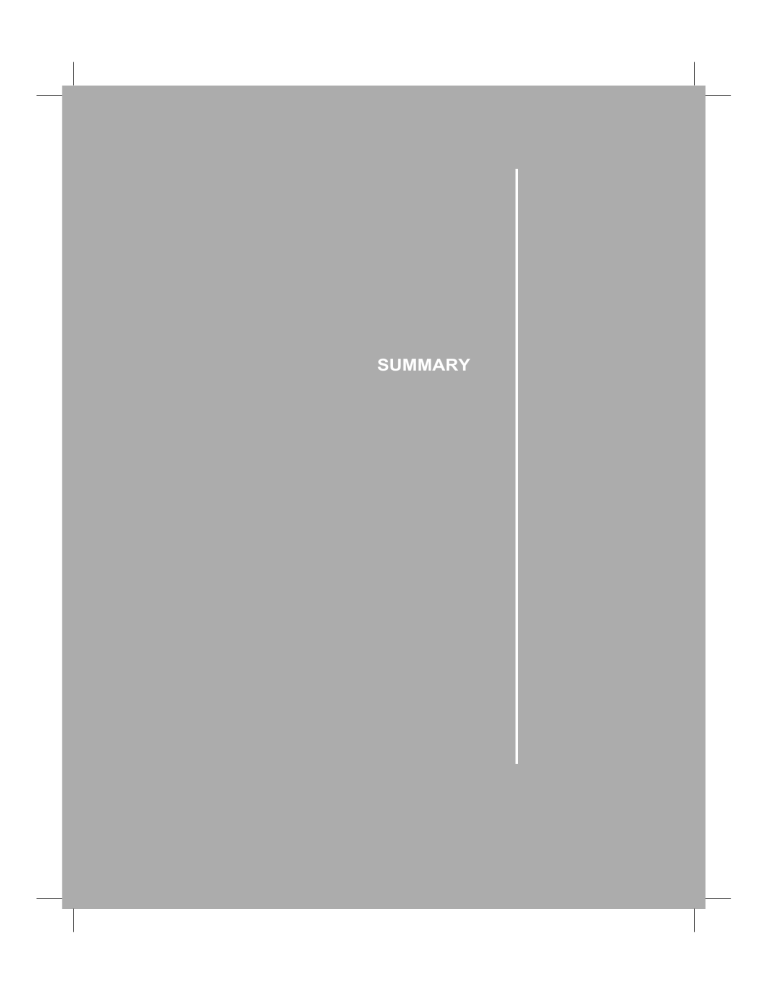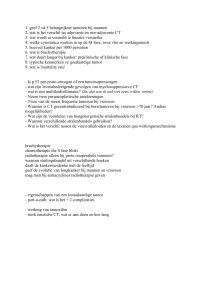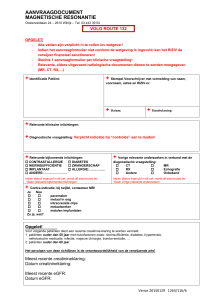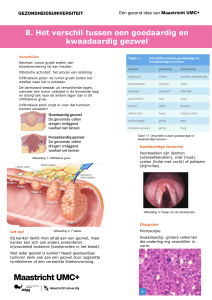
SUMMARY
151
152
Summary
Summary
In chapter 1 a general introduction is provided, in which head and neck
carcinogenesis, its epidemiology and the role of oncogenic HPV-infection in
oropharyngeal squamous cell carcinoma (OPSCC), is reviewed. Particularly,
the incidence of HPV-positive OPSCC has increased significantly worldwide
over the last decades. In this context the influence of different HPV detection
methods on supposed incidence rates is discussed. An overview of HPVsubtypes and HPV-induced carcinogenesis is provided, including the process
in which viral oncoproteins affect essential cellular processes, such as the cell
cycle and apoptosis. By this means, it becomes obvious that HPV-positive
OPSCC have to be regarded a separate tumour entity with differing molecular
and clinical characteristics. The aims and outline of the present thesis are
described in the end of the chapter.
Because the cyclin dependent kinase inhibitor p16INK4A is active in HPV-positive
OPSCC, but often deleted or inactivated in HPV-negative tumours, it is of great
scientific and clinical interest to see whether or not immunohistochemical
p16INK4A staining is a reliable surrogate marker for the presence of both low-risk
(LR) and high-risk (HR)-HPV in benign and (pre)malignant head and neck
lesions. Therefore, in chapter 2, p16INK4A immunohistochemistry was
performed on paraffin-embedded tissue sections of 162 OPSCC, 14 tonsillar
and 23 laryngeal dysplasias, and 20 tonsillar and 27 laryngeal papillomas, and
correlated to HPV-status. PCR, enzyme-immunoassay and FISH analyses
were used to assess HPV-presence and type. P16INK4A immunostaining
patterns were first scored on a semiquantative scale: score 0 (<5% of cells
being p16INK4A positive) to score 3 (>25% positive cells). In addition, p16INK4A
staining patterns were scored according to the ‘block-type’ immunopositivity
approach, defined as p16INK4A being block positive if continuous (>70%) strong
nuclear with or without cytoplasmic staining is present (in all head and neck
lesions) and staining is observed in the basal cell layer with extension upwards
(in the benign and premalignant lesions). Thirty-one percent of OPSCC and
71% of tonsillar dysplasias were HPV16-positive. Sixteen percent of the
laryngeal dysplasias and 96% of the laryngeal papillomas were positive for
HPV6 or -11 and surprisingly all tonsillar papillomas were HPV-negative. We
hypothesize that this HPV-negativity is caused by elimination of the virus by the
immune system with persistence of the lesions, or by the fact that other
viruses, yet to be discovered, play an etiological role in the development of the
tonsillar papillomas. P16INK4A immunohistochemistry revealed a strong (score 3)
and block-positive nuclear and cytoplasmic staining in 50 out of 51 HPV16positive and 5 out of 111 HPV-negative OPSCC, resulting in a highly significant
correlation with HPV-positivity. All HPV16-positive tonsillar dysplasia samples
153
S
also showed a strong (score 3) p16INK4A expression, 8 of these being blockpositive. In contrast, highly variable staining patterns were detected in the
papillomas and laryngeal dysplasias, irrespective of HPV-status. These results
indicate that a strong nuclear and cytoplasmic p16INK4A immunostaining pattern
can indeed accurately predict the presence of HR-HPV16 in OPSCC and
tonsillar dysplasias, with a proposed cut-off level of 70% p16INK4A positive cells.
In the other premalignant and benign head and neck lesions, however, caution
is recommended when using this surrogate marker for HPV-infection.
Literature has shown that the HPV-oncogenes E6 and E7 inactivate p53 and
pRb, respectively, leading to disruption of cell cycle regulation and of the
apoptotic pathway. Chapter 3 evaluates the expression and the prognostic
value of key cell cycle proteins in the pRb and p53 pathways in both HPV16positive and -negative tonsillar squamous cell carcinoma (TSCC). Using
immunohistochemistry, 77 TSCC with known HPV16-status (previously
determined by HPV-specific PCR and FISH) and clinical outcome were
analyzed for expression of proteins in the pRb pathway (p16INK4A, cyclin D1,
p27Kip1 and pRb) and the p53 cascade (p14ARF, MDM2, p53 and p21Cip1/WAF1).
Results were correlated with each other, with other risk factors like alcohol
consumption and smoking, and with clinical and demographic patient data.
Thirty-five percent of TSCC harboured integrated HPV16 and showed p16INK4A
overexpression. These tumours also exhibited overexpression of p14ARF and
p21Cip1/WAF1, as well as downregulation of pRb and cyclin D1 and tended to be
smaller as compared to the HPV-negative cases. Smoking and alcohol abuse
were seen significantly more often in the HPV-negative patient group and there
was a tendency towards more frequent accumulation of p53 in these tumours.
HPV-positive tumours had a significant, favourable survival compared to the
HPV-negative cases. The 5 years disease-specific survival was 31% for
patients with an HPV-negative tumour and 69% for patients with an
HPV-positive carcinoma. In multivariate regression analyses, smaller tumour
size and strong p21Cip1/WAF1 immunostaining appeared to be the most significant
independent indicators for favourable prognosis in TSCC patients. These data
indicate that the carcinogenesis in HPV-associated TSCC is different than that
in tumours induced by smoking and/or alcohol consumption.
Results in previous studies have led to the hypothesis that at least two genetic
routes underlie the development of OPSCC, as the development of smoking/
alcohol induced OPSCC appears to occur via accumulation of distinct
(epi)genetic changes than HPV-induced tumours. In chapter 4 DNA copy
number changes have been analyzed by genome-wide comparative genomic
hybridization (CGH) in a series of 60 OPSCC, of which HPV-status and clinical
data were available. Results have been correlated with HPV-status, clinico-
154
Summary
pathological characteristics, smoking and alcohol intake and disease outcome.
HPV16-positivity was determined by means of HPV-specific PCR and FISH
analysis and positive p16INK4A immunostaining. Forty-nine percent of the
tumours contained HPV16 and showed p16INK4A overexpression. Two thirds of
all OPSCC harboured gain at 3q26.3-qter irrespective of HPV-status. In
HPV-negative tumours this alteration was associated with advanced tumour
stage. In comparison with HPV-positive OPSCC, the HPV-negative tumours
harboured a higher number of chromosomal alterations and amplifications, as
well as significantly more losses at 3p, 5q, 9p, 15q and 18q and
gains/amplifications at 11q13, and, finally, less often 16q losses and Xp gains.
Survival analysis revealed a significantly better 5 year disease-free survival for
HPV-positive OPSCC compared to HPV-negative cases (71% versus 46%,
respectively), whereas chromosome amplification was an unfavourable
prognostic indicator. Interestingly, 16q loss, predominantly identified in
HPV-positive OPSCC, was a strong indicator of favourable outcome and none
of these patients had a tumour recurrence. These results indicate that
HPV-positive and -negative OPSCC show different genetic signatures and
most likely underlie differences in tumour development and progression. In
addition, distinct chromosomal alterations have prognostic significance.
Chapter 5 describes the presence of chromosome instability in a series of
primary TSCC in correlation to HPV16-status and patient survival. Previous
data from cellular model systems are controversial concerning this relation.
Furthermore, we were able to select 8 additional HPV-positive tonsillar
dysplasias, 7 of which were found adjacent to a TSCC, for comparison of
chromosomal (in)stability and the physical status of HPV. Seventy-seven
TSCC, with known HPV16-status and clinical outcome, were analyzed by
FISH, using chromosome 1- and 7-specific centromere DNA probes, to detect
chromosome instability. Forty-two percent of tumours showed HPV16integration and p16INK4A overexpression. Disomy for chromosome 1 and 7 was
significantly more often observed in HPV-positive TSCC compared to the
HPV-negative cases (19 out of 32 tumours versus 10 out of 45 tumours,
respectively). Aneusomy correlated significantly with HPV-negative TSCC,
tobacco- and alcohol consumption and a higher T-stage. Strong p53
immunostaining was also associated with HPV-negative tumours and smoking
and/or alcohol abuse, but not with aneusomy and T-stage. In the dysplasias an
identical HPV and chromosome copy number status was identified as in the
adjacent tumours. The disease specific survival after 5 years was significantly
better for patients with an HPV-positive carcinoma compared to the
HPV-negative TSCC group (30% versus 74%, respectively). Chromosome
instability was a significant indicator for unfavourable prognosis in the total
155
S
TSCC group, but was an even stronger unfavourable prognosticator in the
HPV-positive patient group.
Chapter 6 outlines the incidence and predictive value of HPV-presence and
EGFR expression in a series of advanced OPSCC (n=111) and
hypopharyngeal squamous cell carcinomas (HPSCC, n=46), all treated with
concurrent radiotherapy and chemotherapy (cisplatin). Previous studies that
analyzed EGFR expression in relation to survival in head and neck carcinomas
observed different outcomes. In the present study HPV-positivity was
determined by means of HPV16-specific FISH-analysis in all tumour sections
and HPV-specific PCR in 10 cases. Tissue microarrays of tumour specimens
were subjected to p16INK4A and EGFR immunohistochemistry. Thirty-seven out
of 111 (33%) OPSCC showed strong p16INK4A immunostaining in more than
70% of tumour cells. Thirty-five of these 37 cases contained HPV16 assessed
by FISH analysis. The 2 p16INK4A positive, HPV16 FISH-negative cases proved
to contain HPV33 DNA upon PCR analyses. The HPV-positive OPSCC group
showed a significantly higher male-female ratio and these patients were less
often cigarette smokers than patients with an HPV-negative tumour. 73% of
HPV-positive OPSCC were also EGFR positive compared to 64% EGFR
positive cases in the HPV-negative group (no significant difference).
HPV-positivity was associated with the occurrence of less locoregional
recurrences, less distant metastases and a more favourable overall and
disease free survival. No associations were found between EGFR expression
and survival in the whole OPSCC group and in the HPV-negative group. Within
the HPV-positive group, however, EGFR immunopositive tumours had a
significantly worse survival than EGFR negative cases. Furthermore, 9 out of
31 smokers developed recurrent diseases versus 1 out of 6 non-smokers, but
this difference was not significant. Only 1 HPSCC (2%) was both p16INK4A and
HPV-positive. In addition to previous studies described in this thesis, the
present study makes it more evident that HPV-positive tumours are not a
homogenous group and do not all have a favourable treatment outcome.
Chapter 7 comprises the general discussion and the conclusion of the results
described in this thesis. Moreover, findings are related to recent literature and
future perspectives are discussed.
156
SAMENVATTING
157
158
Samenvatting
Samenvatting
Hoofdstuk 1 geeft een algemene inleiding met een overzicht van de
carcinogenese van hoofd-hals kanker, de epidemiologie en de rol van
oncogene HPV-infectie in de ontwikkeling van het plaveiselcelcarcinoom van
de orofarynx (OPSCC). Met name de incidentie van HPV-positieve OPSCC is
in de afgelopen decennia wereldwijd aanzienlijk toegenomen. In dit licht wordt
de invloed van verschillende HPV-detectiemethoden op veronderstelde
incidentiecijfers besproken. Er wordt een overzicht gegeven van de HPVsubtypes en HPV-geïnduceerde carcinogenese, inclusief het mechanisme
waarmee virale oncoproteïnen essentiële cellulaire processen, zoals de
celcyclus en apoptose, beïnvloeden. Hiermee wordt duidelijk dat HPV-positieve
OPSCC beschouwd kunnen worden als een aparte tumor entiteit met
verschillende moleculaire en klinische kenmerken. Tenslotte worden de doelen
en de opzet van dit proefschrift beschreven.
Omdat de cycline afhankelijke kinase remmer p16INK4A actief is in HPVpositieve OPSCC, terwijl er vaak deletie of inactivatie plaatsvindt in HPVnegatieve tumoren, is het van groot wetenschappelijk en klinisch belang om te
bepalen of immunohistochemische kleuring van p16INK4A een betrouwbare
surrogaat marker is voor de aanwezigheid van zowel laag-risico (LR) als hoogrisico (HR)-HPV in goedaardige en (pre)maligne hoofd-hals laesies. Daarom is
in hoofdstuk 2 p16INK4A immunohistochemie uitgevoerd op paraffineingebedde weefsel coupes van 162 OPSCC, 14 tonsil- en 23 larynx
dysplasieën en 20 tonsil- en 27 larynx papillomen, en is dit gecorreleerd aan de
HPV-status. PCR, enzym-immunoassay en FISH analyses werden gebruikt om
de aanwezigheid van HPV en het HPV-type te bepalen. P16INK4A immunokleuringspatronen werden eerst gescoord op een semikwantitatieve schaal:
score 0 (<5% van de cellen p16INK4A positief) tot score 3 (>25% positieve
cellen). Daarnaast werden de p16INK4A kleuringspatronen gescoord volgens het
principe van ‘bloktype’ immunopositiviteit, gedefinieerd als een blok-positieve
p16INK4A kleuring wanneer er continue (>70%) sterke nucleaire - met of zonder
cytoplasmatische aankleuring - aanwezig is (in het geval van alle hoofd-hals
laesies) en wanneer er kleuring wordt waargenomen in de basale cellaag met
uitbreiding naar boven (in het geval van goedaardige en premaligne laesies).
Eenendertig procent van de OPSCC en 71% van de tonsil dysplasieën waren
HPV16-positief. Zestien procent van de larynx dysplasieën en 96% van de
larynx papillomen waren positief voor HPV6 of -11. Opvallend was dat alle
tonsil papillomen HPV-negatief waren. Een mogelijke verklaring voor deze
HPV-negativiteit is de eliminatie van het virus door het immuunsysteem met
persisteren van de laesie of doordat andere, nog nader te bepalen, virussen
een etiologische rol spelen in de ontwikkeling van de tonsil papillomen.
159
S
P16INK4A immunohistochemie toonde een sterke (score 3) en blok-positieve
nucleaire en cytoplasmatische kleuring in 50 van de 51 HPV16-positieve en 5
van de 111 HPV-negatieve OPSCC, resulterend in een zeer significante
correlatie met HPV-positiviteit. Alle HPV16-positieve tonsil dysplasieën toonden
ook een sterke (score 3) p16INK4A expressie en 8 van deze waren ook blokpositief. Daarentegen werden zeer variabele kleuringpatronen gezien in de
papillomen en larynx dysplasieën, ongeacht de HPV-status. Deze resultaten
tonen aan dat een sterke nucleaire en cytoplasmatische p16INK4A immunokleuring inderdaad nauwkeurig de aanwezigheid van HR-HPV16 in OPSCC en
tonsil dysplasieën kan voorspellen, met een voorgestelde afkapwaarde van
70% p16INK4A positieve cellen. In de overige premaligne en goedaardige hoofdhals laesies is voorzichtigheid geboden bij gebruik van deze surrogaat marker
voor HPV-infectie.
De literatuur heeft aangetoond dat de HPV-oncogenen E6 en E7 zorgen voor
inactivatie van p53 en pRb, resulterend in een verstoring van de celcyclus en
de apoptose pathway. Hoofdstuk 3 onderzoekt de expressie en de
prognostische waarde van de belangrijkste celcyclus eiwitten in de pRb en p53
pathways in zowel HPV16-positieve als -negatieve tonsillaire plaveiselcelcarcinomen (TSCC). Met behulp van immunohistochemie werd in 77 TSCC,
met bekende HPV16-status (eerder bepaald door middel van HPV-specifieke
PCR en FISH) en klinische uitkomstmaten, de expressie van eiwitten in de pRb
pathway (p16INK4A, cycline D1, p27Kip1 en pRb) en de p53 cascade (p14ARF,
MDM2, p53 en p21Cip1/WAF1) geanalyseerd. De resultaten werden gecorreleerd
met elkaar, met risicofactoren zoals alcohol en roken en klinische en
demografische patiëntgegevens. Vijfendertig procent van de TSCC had
geïntegreerd HPV16 en toonde tevens p16INK4A overexpressie. Deze tumoren
lieten ook overexpressie van p14ARF en p21Cip1/WAF1 en downregulatie van pRb
en cycline D1 zien en er was een tendens tot kleinere tumorafmetingen in
vergelijking met de HPV-negatieve gevallen. Roken en alcoholmisbruik werden
significant vaker gezien in de HPV-negatieve patiëntengroep en er was een
tendens naar frequentere accumulatie van p53 in deze tumoren. HPV-positieve
tumoren hadden een significant gunstigere overleving in vergelijking tot de
HPV-negatieve gevallen. De ziektespecifieke overleving na 5 jaar was 31%
voor patiënten met een HPV-negatieve tumor en 69% voor patiënten met HPVpositieve carcinomen. Uit multivariate regressie analyse bleek dat kleinere
tumorgrootte en sterke p21Cip1/WAF1 immunokleuring de belangrijkste
onafhankelijke indicatoren waren voor een gunstige prognose in TSCC
patiënten. Deze gegevens laten zien dat de carcinogenese bij HPVgeassocieerde TSCC anders is dan in door roken en/of alcohol geïnduceerde
tumoren.
160
Samenvatting
Resultaten uit eerdere studies hebben geleid tot de hypothese dat tenminste
twee genetische routes ten grondslag liggen aan de ontwikkeling van OPSCC,
omdat de ontwikkeling van roken en/of alcohol geïnduceerde OPSCC lijkt op te
treden via accumulatie van andere (epi)genetische veranderingen dan die van
HPV-geïnduceerde tumoren. In hoofdstuk 4 werden veranderingen in DNA
kopie aantallen geanalyseerd door genoombrede comparative genomic
hybridization (CGH) in een reeks van 60 OPSCC, waarvan de HPV-status en
klinische gegevens al beschikbaar waren. De resultaten zijn gecorreleerd met
HPV-status, clininicopathologische kenmerken, roken en alcoholgebruik en met
ziekte uitkomst. HPV16-positiviteit werd bepaald door middel van HPVspecifieke PCR en FISH analyse en positieve p16INK4A immunokleuring.
Negenenveertig procent van de tumoren bevatte HPV16 en toonde p16INK4A
overexpressie. Tweederde van alle OPSCC liet winst zien van 326.3-qter
ongeacht de HPV-status. In HPV-negatieve tumoren was deze verandering
geassocieerd met een verder gevorderd tumor stadium. In vergelijking tot HPVpositieve OPSCC hadden HPV-negatieve tumoren een groter aantal
chromosomale afwijkingen en amplificaties, alsmede significant vaker verlies
van 3p, 5q, 9p, 15q en 18q en winst/ amplificaties van 11q13 en ten slotte
minder vaak 16q verlies en Xp winst. Overlevingsanalyse toonde een
significant betere 5-jaars ziektevrije overleving voor HPV-positieve OPSCC in
vergelijking tot HPV-negatieve gevallen (respectievelijk 71% versus 46%),
terwijl chromosomale amplificatie een ongunstige prognostische factor was.
Interessant was de observatie dat 16q verlies, voornamelijk gevonden in HPVpositieve OPSCC, een sterke indicator voor een gunstige prognose was en dat
geen van deze patiënten een tumorrecidief had. Deze resultaten laten zien dat
HPV-positieve en -negatieve OPSCC verschillende genetische kenmerken
hebben die waarschijnlijk ten grondslag liggen aan verschillen in tumor
ontwikkeling en progressie. Bovendien hebben verschillende chromosomale
afwijkingen prognostische betekenis.
In hoofdstuk 5 wordt de aanwezigheid van chromosomale instabiliteit in een
serie primaire TSCC gecorreleerd met HPV16-status en patiëntenoverleving.
Voorgaande data uit cellulaire modelsystemen zijn tegenstrijdig wat deze
relatie betreft. Tevens zijn we in staat geweest om 8 extra HPV-positieve tonsil
dysplasieën te selecteren, waarvan 7 werden gevonden naast een TSCC, voor
een vergelijking van chromosomale (in)stabiliteit en de fysieke toestand van
HPV. Zevenenzeventig TSCC, met bekende HPV16-status en klinische
uitkomsten, werden geanalyseerd door middel van FISH met behulp van
chromosoom 1- en 7-specifieke centromeer DNA-probes om chromosomale
instabiliteit te detecteren. Tweeënveertig procent van de tumoren toonde
HPV16-integratie en p16INK4A overexpressie. Disomie voor chromosoom 1 en 7
werd significant vaker gezien in HPV-positieve TSCC in vergelijking tot de
161
S
HPV-negatieve gevallen (respectievelijk 19 van de 32 versus 10 van de 45
tumoren). Aneusomie was significant gecorreleerd met HPV-negatieve TSCC,
tabak- en alcoholgebruik en een hoger T-stadium. Ook sterke p53
immunokleuring was geassocieerd met HPV-negatieve tumoren en roken en/of
alcohol misbruik, maar niet met aneusomie en T-stadium. In de dysplasieën
werden identieke HPV-status en chromosomale kopie aantallen gezien als in
de aangrenzende tumoren. De ziektespecifieke overleving na 5 jaar was
significant beter voor patiënten met HPV-positieve carcinomen in vergelijking
tot de HPV-negatieve TSCC groep (respectievelijk 30% versus 74%).
Chromosomale instabiliteit was een significante indicator voor een ongunstige
prognose in de totale TSCC groep, maar was zelfs een nog sterkere
ongunstige voorspeller in de HPV-positieve patiënten groep.
Hoofdstuk 6 beschrijft de incidentie en de voorspellende waarde van de
aanwezigheid van HPV en EGFR expressie in een serie vergevorderde
OPSCC (n=111) en plaveiselcelcarcinomen van de hypofarynx (HPSCC,
n=46), allemaal behandeld met gelijktijdige radiotherapie en chemotherapie
(cisplatine). Eerdere studies die de relatie tussen EGFR expressie in hoofdhals carcinomen en overleving analyseerden, toonden verschillende
uitkomsten. In de huidige studie werd HPV-positiviteit bepaald door middel van
HPV16-specifieke FISH analyse in alle tumorcoupes en HPV-specifieke PCR in
10 gevallen. Op tissue microarrays van de tumor exemplaren werd p16INK4A en
EGFR immunohistochemie verricht. Zevenendertig van de 111 (33%) OPSCC
liet een sterke p16INK4A immunokleuring zien in meer dan 70% van de
tumorcellen. Vijfendertig van deze 37 gevallen bevatten HPV16, beoordeeld
door middel van de FISH analyse. De 2 p16INK4A positieve, HPV16 FISHnegatieve casussen bleken HPV33-DNA te bevatten bij PCR-analyse. De HPVpositieve OPSCC groep toonde een significant hogere man-vrouw verhouding
en deze patiënten waren minder vaak sigarettenrokers dan patiënten met een
HPV-negatieve tumor. Drieënzeventig procent van de HPV-positieve OPSCC
waren ook EGFR positief ten opzichte van 64% EGFR positieve gevallen bij de
HPV-negatieve groep (geen significant verschil). HPV-positiviteit was
geassocieerd met het optreden van minder locoregionale recidieven, minder
metastasen op afstand en een gunstigere algehele - en ziektevrije overleving.
Er werden geen associaties gevonden tussen EGFR expressie en overleving in
de hele OPSCC groep en in de HPV-negatieve groep. Binnen de HPVpositieve groep hadden EGFR immunopositieve tumoren echter een significant
slechtere overleving dan EGFR negatieve gevallen. Bovendien ontwikkelden 9
van de 31 rokers een recidief van de ziekte versus 1 van de 6 niet-rokers,
hoewel dit verschil niet significant was. Slechts 1 HPSCC (2%) was zowel
p16INK4A en HPV-positief. In aanvulling op eerdere studies beschreven in dit
162
Samenvatting
proefschrift, maakt de huidige studie duidelijk dat HPV-positieve tumoren geen
homogene groep zijn en niet allemaal een gunstige therapie uitkomst hebben.
Hoofdstuk 7 bevat de algemene discussie en de conclusie van de in dit
proefschrift beschreven resultaten. Bovendien zijn bevindingen vergeleken met
de recente literatuur en worden toekomstperspectieven besproken.
S
163












